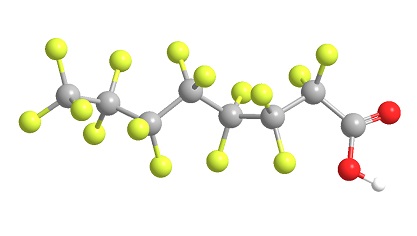Пентадекафтороктановая кислота химические свойства, назначение, производство
Описание
Concerns about the potential environmental and toxicological
impacts of long-chain perfluoroalkyl sulfonates and
carboxylic acids have led to: (1) the phaseout of production of
perfluorooctane sulfonate (PFOS) and related compounds
and perfluorooctanoic acid (PFOA) by their major global
manufacturer in 2000–02; (2) the conclusion of a stewardship
agreement between the United States Environmental Protection
Agency (US EPA) and eight leading global companies to
reduce emissions and product content of PFOA and related
chemicals by 95% by 2010 and to work toward their elimination
by 2015; (3) a similar agreement between the
Canadian environmental and health authorities and five
companies to restrict perfluorinated carboxylic acids in
products; (4) a European Union Marketing and Use Directive
restricting the use of ‘PFOSs’ in the European Union; and
(5) the inclusion of PFOS in the Stockholm Convention on
Persistent Organic Pollutants as an Annex B substance,
i.e., restricted in its use; and other regulatory and voluntary
initiatives intended to reduce environmental emissions of this
family of compounds.
Химические свойства
Perfluorooctanoic acid is a white to off-white powder or colorless flakes. It is very soluble in water.It has a pH of 2.6. Perfluorooctanoic acid has the ability to react with bases, oxidizing agents, and reducing agents. Upon decomposition, PFOA can form carbon oxides and hydrogen fluoride. Additional information related to physical and chemical properties of PFOA are not currently available.

Использование
Perfluorooctanoic acid (PFOA) is fluorinated surfactant used, primarily as its ammonium salt (APFO), as an aid in the chemical synthesis of fluoropolymers and fluoroelastomers. As such, it may be found in nonstick cookware and utensils, stain-repellant fabric treatments, and water-proofing treatments for garments. Although an effort is underway by the U.S. EPA to reduce use of and replace perfluoroalkyls with other substances, PFOA is still used in United States industry.
Perfluorooctanoic acid (PFOA, C8, pentadecafluorooctanoic acid, perfluoro caprylic acid) is an eightcarbon compound in the perfluoroalkyl family of chemicals. Perfluorooctane sulfonate is used in a variety of applications, including nonstick cookware, waterproof clothing, leather products, cleaning products, and pesticides. Its main use was as a stain repellent on carpet, furniture, and other consumer products. In 2006, the U.S. Protection Agency along with eight major companies that utilized PFOA embarked on a program to reduce emissions and use of the chemical by 2015 (USEPA, 2012).
Определение
ChEBI: A fluoroalkanoic acid that is perfluorinated octanoic acid.
Общее описание
Perfluorooctanoic acid is a perfluoroalkyl acid commonly used in the preparation of fluoroacrylic esters, fluoropolymers and fluoroelastmers. It is found to be environmentally persistent and bioaccumulative with a long half-life.
Профиль безопасности
Poison by intraperitoneal route. Mutation data reported. Whenheated to decomposition it emits toxic vapors of Fí.
Экологическая судьба
Perfluorooctanoic acid found in the environment may result from waste stream releases from manufacture of cosmetics, lubricants, paints, polishes, adhesives, fabric treatments, and fire-fighting compounds. It can partition to the vapor phase in the atmosphere, where it is degraded atmospherically with a half-life of 31 days. It is very resistant to hydrolysis, and immobile in soil. It will not likely evaporate from soil (depending on soil pH) or surface waters. It is not expected to be absorbed to sediments and suspended particles. Perfluorooctanoic acid is not expected to bioaccumulate in aquatic organisms (BCF =3.1–9.4) (NLM, 2013).
Методы очистки
Crystallise the acid from CCl4 and toluene, and distil it. It forms micelles in H2O and the solubility is 1% in H2O. The acid chloride has b 129-130o/744mm. The amide has m 138o. [Bernett & Zisman J Phys Chem 63 1911 1959, Bro & Sperati J Polym Sci 38 289 1959, Beilstein 2 IV 994.]
Пентадекафтороктановая кислота препаратная продукция и сырье
сырьё
препарат